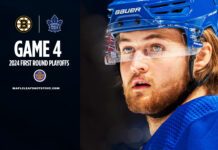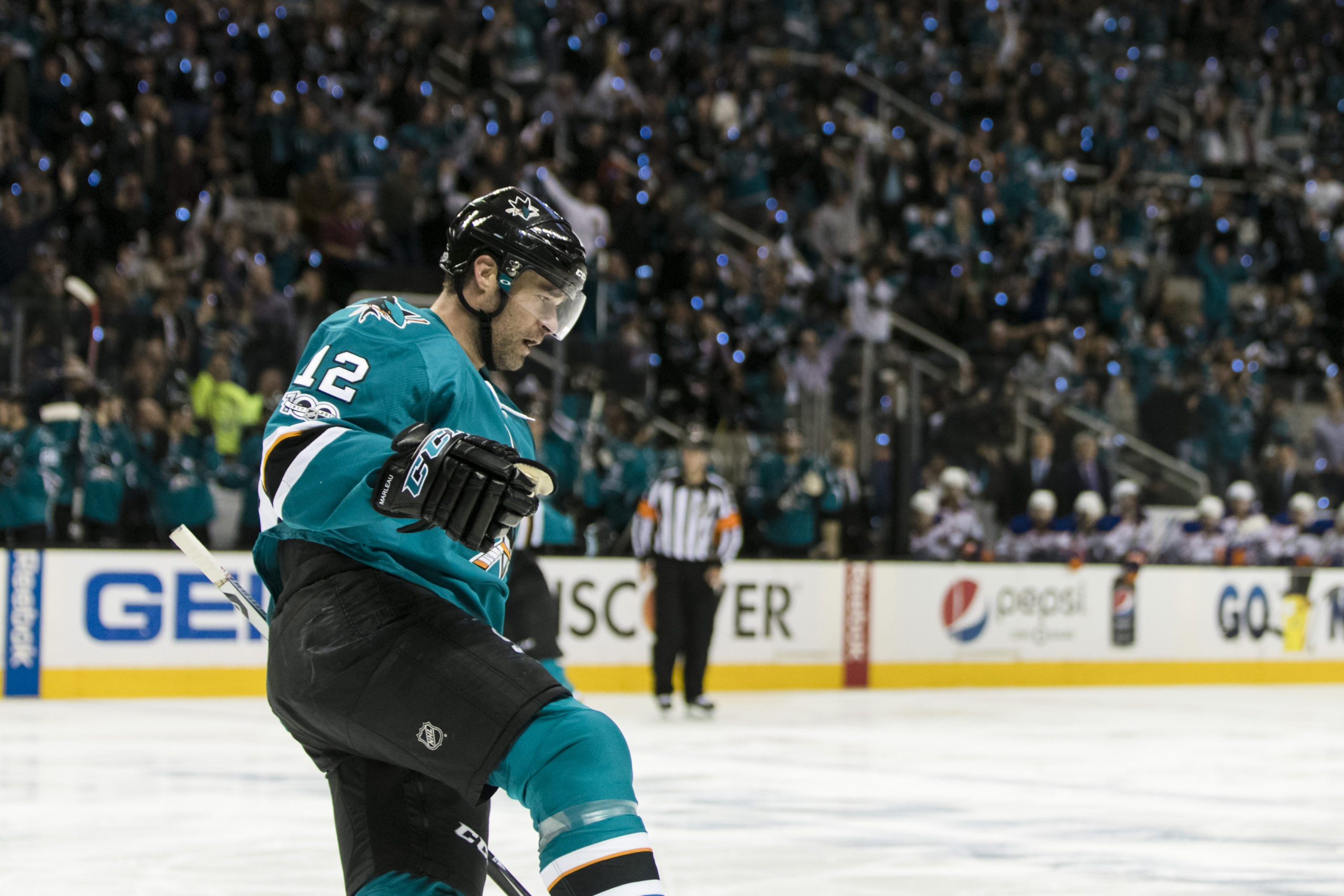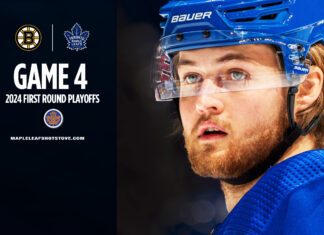Some thoughts in note form as we digest a wild couple of days for the Toronto Maple Leafs.
– Whatever you think about the contract, it’s pretty unbelievable to be sitting here, 14 months after the Leafs finished dead last and had only a 24% chance of winning the draft lottery to look forward to, talking about how the Leafs just added Patrick Marleau at age 38 to help them go on playoff runs in the next two-to-three years.
– There’s no getting around the fact that Marleau’s production has seen a steady, natural decline as he’s aged: two consecutive seasons with under 50 points is a first since 1998-2000 (when he was 19-20), and his 46 points last year was his lowest since 2001-02.
His 27 goals last season came despite his lowest shots on goal total in nine seasons. Marleau’s SOG totals have fallen steadily over the last three years — 233, 216, 190 — and his 17:09 TOI in 2016-17 was his lowest since 2001-02. The recent decline was driven by special teams, however, and not his 5v5 rates:
| 5v5 Shots | EVS/60 | PP Shots | PPS/60 | EV TOI/G | PPTOI/G | |
|---|---|---|---|---|---|---|
| 2016-17 | 144 | 7.82 | 35 | 8.68 | 14:02 | 3:01 |
| 2015-16 | 133 | 7.32 | 59 | 12.41 | 14:41 | 3:31 |
| 2014-15 | 138 | 7.29 | 65 | 15.19 | 14:54 | 3:16 |
In addition to a 30-second reduction in PP ice time for Marleau individually last year, the Sharks power play struggled — it finished 25th overall (16.7%) and 16th in shots on goal per hour. Not that Marleau didn’t have a hand in that given he played three minutes a game on the PP, but he now joins a Leafs team that was second in the NHL with a 23.8% success rate and fifth in shots on goal per 60.
As far as the ice time: The reduction last season was due to Pete DeBoer cutting his power play time slightly and moving him off the penalty kill entirely. He’s remained within a few seconds of Tomas Hertl for third among Sharks forwards in even strength ice time per game over the past three seasons, behind Thornton and Pavelski.
He’s slowing down, but by no means does it look like he’s teetering over the cliff face at this point.
– Here is a list of players 38 and older who have recorded 20+ goal seasons since 2005-06:
| Rk | Player | From | To | Count |
|---|---|---|---|---|
| 1 | Teemu Selanne | 2009 | 2012 | 4 |
| 2 | Bill Guerin | 2009 | 2010 | 2 |
| 3 | Jaromir Jagr | 2014 | 2016 | 2 |
| 4 | Mark Recchi | 2007 | 2009 | 2 |
| 5 | Brendan Shanahan* | 2007 | 2008 | 2 |
| 6 | Martin St. Louis | 2014 | 2015 | 2 |
| 7 | Daniel Alfredsson | 2012 | 2012 | 1 |
| 8 | Shane Doan | 2016 | 2016 | 1 |
| 9 | Marian Hossa | 2017 | 2017 | 1 |
| 10 | Jarome Iginla | 2016 | 2016 | 1 |
| 11 | Mike Knuble | 2011 | 2011 | 1 |
| 12 | Joe Nieuwendyk* | 2006 | 2006 | 1 |
| 13 | Gary Roberts | 2007 | 2007 | 1 |
| 14 | Ray Whitney | 2012 | 2012 | 1 |
It’s been done 22 times by 14 different players in the last 11 years. St. Louis (x2), Selanne (x4), Shanahan (x2), Jagr (x2) and Guerin (x2), Recchi (x2) are the six 38+ players to do it multiple times. Selanne is the only one to have done it three or more times.
If we stretch the sample back to 1995-96 when the 82-game season was implemented, the list grows only from 14 players to 19. Only five 38 and older players managed to break 20 goals between 1995-96 and 2005-06, compared to 14 from 2005-06 to 2016-17. That certainly says something about the modern NHL athlete and the advancements in sports science in general.
– In terms of 25+ goal scorers at age 38 and older since 2015-16 — seven have done it once: Alfredsson, Doan, Hossa, Jagr, Nieuwendyk, Shanahan, and St. Louis. Only one has done it more than once (Selanne, four times).
– If we go by Marleau’s commitment to his preparation late in his career, it sure sounds like he’s got a good shot at joining the multi-20+ goal club among 38 and over players. Here’s Sharks head coach Pete DeBoer, who also coached Jaromir Jagr in New Jersey:
I think all guys who have played that long I’ve coached — No. 1, it’s a passion for the game. They love the game, they love to come to the rink and they love the extra work you have to do in the gym, the sacrifices you have to make. Not everyone has that, especially when you get 15-20 years in and you have a family and you’ve made enough money that you don’t have to put your body on the line every night. It’s a rare breed who can do that that long. And his physical tools allow him to keep playing. He’s a generational skater, a big man, a linebacker-type body, which is a great recipe for playing a long time.”
As has been mentioned elsewhere, Marleau hasn’t missed a game since April of 2009, when he sprained his MCL. That puts his games played streak at 563 games (regular season), which is behind only Keith Yandle and Andrew Cogliano among active players. Marleau has never played fewer than 74 games in an 82-game season.
Here was Marleau earlier this year speaking about his durability:
Probably good genetics and I’ve had a really great supporting cast with the trainers here throughout my career. They always bring new ideas to the forefront. Honestly, when I first came in guys weren’t taking vitamins every day or eating healthy. It’s evolved over the years. More and more guys are turning to that healthier lifestyle. It helps players such as myself stay young, stay fit, and keep the fire burning.
Every player has little things they do away from the rink as well, whether that be a massage person that they go see from time to time. There’s many different types of massage now, like the cupping you saw at the Olympics. You go around and you try different things and you see what works for you and you apply it, and those people become part of your supporting cast. I’ve had numerous massage therapists with different techniques. You get to know a lot of therapist around the league so even when you’re on the road you know who to call. It’s about staying on top of all the injuries. Those little bumps and bruises—if you don’t take care of them they add up and turn into something major.
– Mike Babcock’s quote when asked by NHL.com’s Nick Cotsonika about the three-year term: “Have you seen the guy skate?”
Joe Thornton shared a similar thought after Patrick Marleau scored his 500th goal in February: “I think he is still one of the most explosive players in the league.”
– Marleau should be set up pretty well to succeed in Toronto for the next couple of years. With what’s already in place, there isn’t the expectation that he’ll step in, play first-line minutes, and lead the team in goal scoring. When Babcock had the new influx of offensive talent at his disposal last season, he optimized the forward lines pretty quickly and received career years out of Kadri, Bozak and JVR up front, on top of the big years from the rookie class.
There are several spots where Marleau could slide nicely into the Leafs’ highly-skilled top nine; you could foresee him with Bozak and Marner at times this year, where he’d have two right-handed playmakers feeding him passes in secondary matchups. He mostly played with left-handed centers in San Jose between Couture and Thornton the last two years — both fantastic players who Marleau enjoyed considerable success with, and in Thornton’s case one of the best playmakers to ever live, but it would be a different dynamic.
Of course, him taking over Hyman’s spot on Nylander and Matthews’ line is a tantalizing prospect as well, although we’ll see if Babcock is willing to forgo the “digger” role on the left side of that line.
We can be sure Babcock is tearing through pens and napkins at his cottage with all of the possibilities here.
– As of now, however, the Marleau add does bump a kid off the team who probably deserves a spot in the lineup and it’s hard not to see that player being Kasperi Kapanen (still waiver exempt) as things currently stand. Where Josh Leivo or Nikita Soshsnikov’s futures lie at this point is about as clear as mud, but it’s hard to see them staying on the Leafs roster past October as it stands. Could Kasperi Kapanen emerge as a 15-20 goal, 40-point player for a small fraction of Marleau’s pricetag within the next two years if afforded top-nine minutes plus his PK shifts and potentially some secondary power play time? As a RW, Kapanen is stuck behind Nylander, Marner and Brown right now unless Babcock feels he can be trusted on his off side. How about Soshnikov, or Leivo?
Hard to bank on 20+ goals from any of them in the next two years like you’re getting from Marleau, and there are factors beyond the points (“He can play against the best players and do it right,” said Babcock).
– It’s still premature to assume JVR won’t be a Leaf come October. Certainly, things look to be pointing strongly in the direction of him not being in Toronto past 2017-18, and if the Leafs can get the right defenceman for him, he’ll be on the next plane out of town. But to load up on short-term veterans (medium term, in Marleau’s case) with the goal of capitalizing on an entry-level window and then turn around and deal JVR — still the team’s best LWer offensively, in his prime, and a top-25 scorer in the league since 2012-13 — for whatever the team can get in terms of futures, be it picks or young defencemen in need of development time, doesn’t make a lot of sense. It would obviously have to be for the right piece, and that’s the case now more than before the Marleau signing.
– Without that piece, the concern with the Marleau signing is whether the Leafs just shifted into win-now mode without the defensive strength to do it. It’s not “win-now” in the sense that the Leafs sacrificed significant future assets in the form of quality picks or prospects, but $6.25 million in cap space for three years is a pretty substantial commitment that comes with certain expectations and risks (there are all sorts of ways the Leafs could get out of that third year if Marleau is going to retire or accept a trade, or both, but we don’t know how it will play out. Could even be a lockout).
If the Leafs do nothing else of significance this offseason, we’re left with lots of maybes defensively: How much does the team improve just by virtue of having a more mature forward group that now includes Marleau and Dominic Moore (for a full 82 games, versus Brian Boyle for 20) and a collection of talented rookies with a year of NHL experience now under their belts? Does Morgan Rielly have another level to find, entering his age-23 season and his third year playing tough minutes under Babcock (after an up-and-down regular season, he was fantastic in the playoffs)? Does Nikita Zaitsev have more to give in his second year in North America? How close to ready are Calle Rosen, Andreas Borgman, Andrew Nielsen, and Travis Dermott?
– We can get this out of the way: Barring further moves, Ron Hainsey is going to play some significant minutes for the team this season, and it won’t always be pretty at his age and foot speed. But he’s averaged 21+ minutes a game for the last ten years on five different teams, and over 21 minutes a game during the Penguins Cup run last season while taking on the top matchups each night. He can play the right side, where the Leafs had only Nikita Zaitsev and Connor Carrick (who played 15:31 per game in the final month of the season, and 12:16 on average in the team’s six playoff games) among their regular NHL defencemen, with no one in the system ready to step in. That’s unless Babcock thinks Calle Rosen, who played some RD in the SHL, is not only ready for regular NHL duty but can also be introduced to the league on his off-side, which seems unlikely and ill-advised.
Hainsey is also 20th in the NHL in shorthanded time-on-ice per game in the last ten years among active defencemen with more than 200 games played, including over three minutes per game in Carolina this past year. When the Hurricanes traded Hainsey on February 23rd, their PK was ranked second in the league. It ranked 18th in the league from February 23 onward. Over the last three years, Hainsey’s 45.7 shots against per hour of PK time is 17th of 151 defencemen (minimum 200 SH minutes).
As far as stopgap measures go, there are worse solutions than Hainsey on a two-year deal. But for a team that was 28th in shots against and 22nd in goals against (worst among the 16 playoff teams in both categories), the Leafs don’t appear to have a core assembled defensively that is capable of putting them over the top, unless you believe they can really pull off a 2017 Penguins, Hainsey and all. That’s not news to anyone here and it certainly isn’t lost on Leafs management.

































